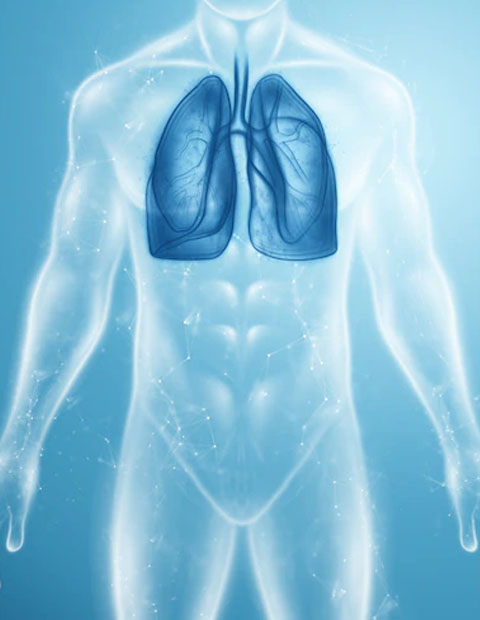What is lung cancer?
Lung cancer begins in the lungs and can spread to lymph nodes or other organs in the body, such as the brain. In turn, cancer originating in other organs can spread to the lungs. When cancer cells spread from one organ to another, it is called metastasis.
Lung cancers are generally grouped into two main types, small cell and non-small cell (including adenocarcinoma and squamous cell carcinoma). These types of cancer grow differently and require different treatments. Non-small cell lung cancer is more common than small cell lung cancer.
The lungs are a pair of cone-shaped organs that are used for breathing and are located in the thorax. As you inhale, oxygen passes through the lungs and enters the body. As you exhale, the lungs release carbon dioxide, a waste product of the body’s cells. Each lung has sections called lobes. The left lung has two lobes. The right lung is slightly larger and has three lobes. The bronchi are two tubes into which the trachea divides and which continue to the right lung and the left lung.
Sometimes lung cancer also affects the bronchi. Inside the lungs are tiny air sacs called alveoli and small tubes called bronchioles.

Types of lung cancer
There are two main types of lung cancer that are treated in very different ways.
- Non-small cell lung cancer: is a disease in which malignant (cancer) cells form in the tissues of the lung, accounting for 80% of all cases of lung cancer. This type of cancer includes many different kinds of cells:
– Squamous cell carcinoma : Cancer that forms in the thin, flat cells that line the inside of the lungs. Also called squamous cell carcinoma.
– Large cell carcinoma : Cancer that begins in several types of large cells.
– Adenocarcinoma : Cancer that begins in the cells that line the alveoli and make substances such as mucus. - Small cell lung cancer: is a disease in which malignant (cancer) cells form in the tissues of the lung, accounting for 20% of all cases of lung cancer. This form of lung cancer grows faster, is very aggressive, and metastasizes relatively quickly. Types of small cell lung cancer are named based on the type of cells and how they look when viewed under a microscope, naming them as:
– Small cell carcinoma (oat grain cell cancer).
– Combined small cell carcinoma.

Lung cancer in Mexico.
In 2020, an incidence of more than 2 million cases of lung cancer worldwide and around 1.8 million deaths from this cause were estimated. In Mexico, 7,811 new cases and 6,733 deaths from lung cancer were registered. In our country, mortality trends from this cancer have decreased in different magnitudes and specific periods. From 1990 to 2016, the mortality rate dropped an average of 1.9% each year at the national level; this decrease varied between men and women (2.1% and 1.4% per year, respectively). Despite this, more cultural information, accessibility to health services, as well as environmental exposure is still required to link the effect of these factors on the development of this disease, to prevent its appearance in future generations.
At least two of the three epidemiological analyzes found that in the northern states (Baja California, Baja California Sur, Chihuahua, Coahuila, Durango, Nuevo León, Sinaloa, Sonora and Tamaulipas) there was an increase in cancer mortality, and one of these two studies also found an increase in the number of new cases in the same region and in contrast in the peripheral entities of Mexico City reported a decrease in the number of deaths of 30%
Lung cancer in Latin America.
Although cancer is the second leading cause of death worldwide, lung cancer has become the leading cause of death in Latin America, and it is expected to have an increasing incidence in the region. Projections show that by 2030, there will be more than 151,000 new cases and that the disease will cause about 135,000 deaths, 50% more than today.
Lung cancer worldwide.
Lung cancer is one of the most dangerous silent diseases in the world: it claims about 3 lives per minute, 4 thousand per day and 1.59 million per year.
According to GLOBOLCAN 2018, cancer is the leading cause of death worldwide. Each year there are 1.8 million new cases and claims the lives of 9.6 million people in the world, with lung cancer having the highest mortality rate in the general population with 1.8 million deaths.
Although all oncological diseases are important, today the main concern is lung cancer because, unlike other tumors, it is the most aggressive and deadly.
Symptoms.
Symptoms of lung cancer can be:
- Chest discomfort or pain.
- Cough that does not go away or gets worse over time.
- Difficulty breathing.
- Wheezing
- Blood in the sputum (mucus that is expelled from the lungs).
- Hoarseness
- Difficulty to swallow.
- Loss of appetite.
- Weight loss for no known reason.
- Feeling very tired.
- Swelling of the face or neck veins.
Treatments.
Surgery: An operation where the doctor cuts out cancerous tissue.
Chemotherapy : The tumor seeks to reduce or eliminate through the use of drugs. These drugs can be given as tablets or through an IV.
Radiation therapy: Involves the use of high-intensity radiation (similar to X-rays) to kill cancer.
Targeted therapy: Refers to the use of drugs to block the growth and spread of cancer cells. These medicines can be tablets taken by mouth or medicines given through an IV. You will have tests to see if targeted therapy is right for your type of cancer before this treatment is used.

